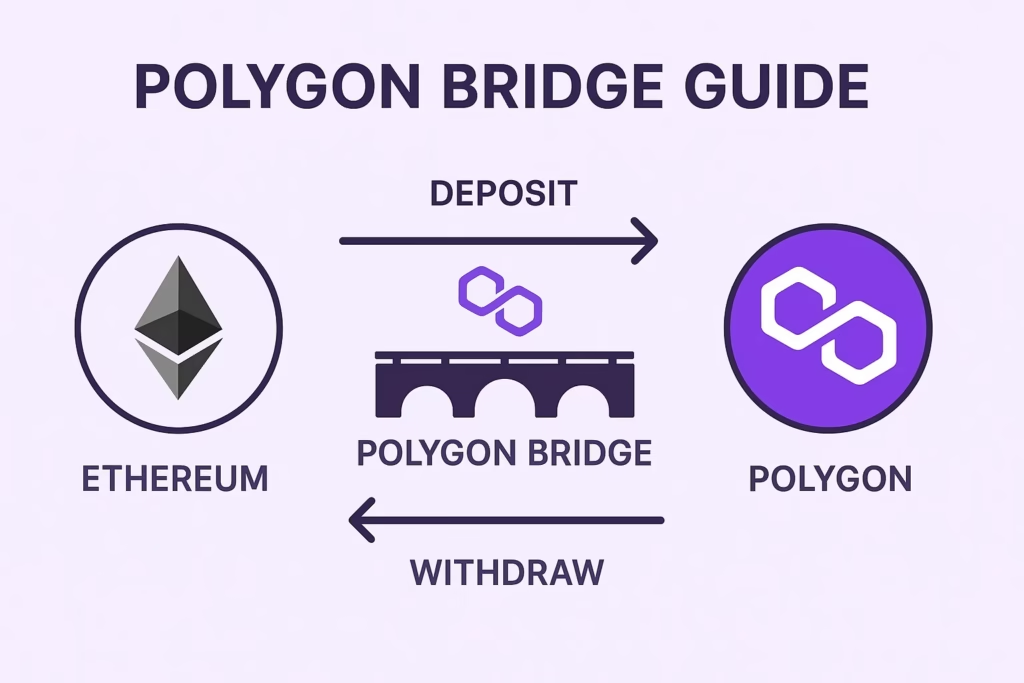- 🔄 The Polygon Bridge enables secure, trustless transfers of tokens and NFTs between Ethereum and Polygon.
- ⚡ Use the Proof-of-Stake (PoS) Bridge for fast, everyday transactions, and the Plasma Bridge for high-value transfers.
- 💰 Save on gas fees, access Polygon’s DeFi ecosystem, and move assets with ease.
In today’s expanding blockchain landscape, interoperability is key. The Polygon Bridge offers a seamless, trustless solution for transferring crypto assets between the Ethereum mainnet and the Polygon network. This guide breaks down how the bridge works, why it’s essential, and how to use it effectively.
What Is the Polygon Bridge?
The Polygon Bridge is a cross-chain protocol that allows users to move ERC-20, ERC-721 (NFT), and ERC-1155 tokens between Ethereum and Polygon. It enables users to enjoy low fees, fast transactions, and access to Polygon’s DeFi, gaming, and NFT ecosystems without leaving Ethereum’s security umbrella.
Why Use the Polygon Bridge?
- Lower Fees: Avoid high Ethereum gas costs.
- Faster Transactions: Enjoy near-instant settlements on Polygon.
- DeFi & NFT Access: Use your Ethereum assets on Polygon dApps.
- Trustless and Secure: Built on smart contracts—no central authority needed.
How Does the Polygon Bridge Work?
- Lock: Assets are locked in an Ethereum smart contract.
- Verify: Transactions are validated on Polygon using cryptographic proofs.
- Mint: Pegged tokens are created on the Polygon network.
- Burn & Unlock: Tokens are burned on Polygon and unlocked on Ethereum during withdrawal.
Types of Polygon Bridges
1. Proof-of-Stake (PoS) Bridge
- Security: Validated by Polygon PoS validators
- Speed: Fast deposits (10–30 minutes)
- Withdrawals: ~3 hours
- Supports: Most tokens and NFTs
2. Plasma Bridge
- Security: Based on Ethereum’s Plasma framework
- Speed: Slower withdrawals (7-day challenge period)
- Supports: ETH, MATIC, and select ERC-20s
- Best For: High-value or institutional transfers
How to Use the Polygon Bridge
Bridge from Ethereum to Polygon
- Go to the official Polygon Bridge: Official Website
- Connect your MetaMask or another Web3 wallet.
- Select the token and amount to transfer.
- Confirm and pay Ethereum gas fees.
- Wait for verification (10–30 mins via PoS Bridge).
- Your tokens will be available on Polygon.
Withdraw Back to Ethereum
- Reconnect your wallet to the Polygon Bridge.
- Select the token and initiate withdrawal.
- Confirm the transaction (burns tokens on Polygon).
- Wait for the challenge/verification period.
- Claim your tokens on Ethereum after completion.
Polygon Bridge Fees
- Bridge Fees: The bridge itself charges no fees.
- Gas Fees: Users pay standard Ethereum gas for deposits and withdrawals.
- Polygon Transactions: Typically cost less than $0.01.
Tip: Use the bridge during periods of low Ethereum congestion to save gas.
Use Cases of the Polygon Bridge
- DeFi Users: Move stablecoins to Polygon for better APYs on platforms like Aave.
- NFT Traders: Transfer NFTs to Polygon for gasless trades on OpenSea.
- GameFi Enthusiasts: Use Polygon’s low-cost network for in-game assets.
- Institutions: Use the Plasma Bridge for secure, large transfers.
Final Thoughts
The Polygon Bridge is an essential tool for anyone using Ethereum. It offers a practical way to avoid congestion, reduce costs, and access Polygon’s vibrant ecosystem. Whether you’re a retail trader, NFT collector, or institutional user, the bridge simplifies the path to scalable blockchain adoption.
Pro Tip: Use the PoS Bridge for everyday transactions and the Plasma Bridge for high-value security-critical transfers.
Conclusion
By enabling seamless token transfers between Ethereum and Polygon, the Polygon Bridge is transforming how we interact with DeFi, NFTs, and Web3 platforms. It’s fast, secure, and unlocks a world of lower fees and greater opportunity.

